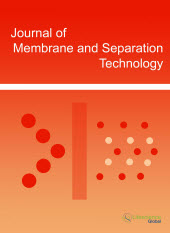jmst
Abstract : An Impact of the Particle Size Distribution on CP Degree at the Mechanism of Shear-Induced Diffusion in Cross-Flow Microfiltration
|
|
Abstract: Model for concentration profile at the mechanism of shear- induced back migration has been proposed. The model is based on the following assumptions: (1) Flow is assumed to be isothermal, incompressible, fully developed and steady– state. The model implies the position dependence of transverse velocity and shear rate; (2) Dispersed phase consists of rigid bodies characterized by identity variables and particle- size distribution; (3) Back migration being non- diffusive in nature is characterized by certain kinetic behavior. The migration of particle is determined by shear- induced force (moving force) and drag forces (resistance force); (4)The migration of particles was assumed to occur within the zone referred to as shear-diffusion migration zone. Migration zone ranges from membrane to its threshold value at the upper boundary where the state of pseudo-equilibrium takes place; Vector sum of the forces acting the particle (shear and drag forces) ranges from its maximum value at the surface of membrane to zero at the upper boundary of migration zone where the state of pseudo-equilibrium takes place; (5) The driving force being degree of deviation from the state of equilibrium was expressed as the difference between local shear rate and its threshold value at the upper boundary of migration zone; Transport mechanisms such as Brownian diffusion, inertial lift, interaction based on Van der Waals or electrostatic forces, combined effects of particle-particle and particle–membrane interactions are outside the scope of the model. The proposed model has the following possible implications: (A) It can be used for quantitative estimation of the probability of fouling caused by different fractions at existing hydrodynamic conditions; (B) The model allows analyzing the impact of hydrodynamic conditions (such as shear stress and transverse velocity) on the probability of fouling caused by certain dispersed fraction; (C) It allows estimation of the threshold value of the shear rate specific for the certain fraction that should be exceed in order to prevent accumulation of this fraction; (D) Proposed model permits analyzing the influence of shear rate at the surface of membrane on the transverse concentration distribution; (E) The model can be used for quantitative analysis of CP distribution of individual fraction while considering poly-disperse systems as soon as any fraction is characterized by its individual migrating behavior. Keywords: Shear-induced diffusion, concentration polarization, cross-flow microfiltration, modeling.Download Full Article |
Abstract : Effect of Operating Variables on DMFC Performance for the Synthesized Si-PWA/PVA Nanocomposite Membrane
|
|
Abstract: Electrochemical Performance of DMFC was studied under the effect of various operating parameters like temperature, methanol concentration and relative humidity (RH) for the synthesized silica immobilized phosphotungstic acid-poly(vinyl alcohol) (Si-PWA/PVA) nanocomposite membrane (thickness 80-100 µm). The optimized 1.5 Si-PWA/PVA membrane showed good electrochemical properties (transport number: 0.92 and IEC: 0.90 meq/g) with excellent mechanical strength, thermal and chemical stability. Open circuit voltage (OCV) decay was significantly lower in comparison to Nafion-117. Maximum power density (45.7 mWcm-2)was obtained at 60oC cell temperature. DMFC performance exhibited better performance even at higher methanol concentration (2 M) demonstrating lower concentration over potential. The appreciable rise in the peak power density observed at higher relative humidity (90%) showed good water stability of the membrane. Performance of the DMFC with the synthesized composite membrane was comparable to the state of the art Nafion-117. Keywords: Nanocomposite membrane, Membrane electrode assembly, proton conductivity, methanol crossover, over-potential.Download Full Article |
Abstract : Development of Ag/GO Incorporated onto PES Membrane with Improved Anti-Fouling Property
|
|
Abstract: Graphene and its derivatives have got increasingly application interests emanating from its unique properties. This work reports silver-graphene oxide sheets (Ag-GO) composite synthesis and then incorporated into Polyethersulfone (PES) casting solution. The composite casting mixtures were cast via phase inversion method. Graphene and its derivatives were characterised by ATR/FTIR, Raman, XRD and TEM. The morphology and performance of the neat PES and composite PES membranes were characterised by SEM, AFM, CA, permeation flux, protein (BSA) rejection, antifouling and antibacterial tests. The composite membranes exhibited a slightly higher permeation flux and then gradual decreased compared to neat PES membranes. However, the antifouling tests revealed that the composite membranes with Ag particles showed a preferable antifouling performance. The antibacterial tests confirmed that the composite membranes exhibited a effective antibacterial performance against both gram-positive (E. coli) and gram-negative (S. Aureus) strains. Keywords: Graphene derivativies, Polyethersulfone, silver particles, antibacterial effect.Download Full Article |
Abstract : Capacitive Deionization for Selective Extraction of Lithium from Aqueous Solutions
|
|
Abstract: The paper deals with extraction of lithium by means of two capacitive deionization systems: one composed of lithium selective electrode and second with electrode wrapped with Li-selective membrane. In the case of the first system, hybrid electrodes where obtained by mixing λ-MnO2sorbent with activated carbon .The best Li-capacity was determined for electrode with 20 wt.-% of manganese oxide. For larger amounts of λ-MnO2 the electrode capacity decreased significantly. The second system was composed of carbon electrodes wrapped with ion-exchange membranes. The lithium selective membranes were synthesized by plasma induced interpolymerization of (meth)acrylic monomersinpores of Celgard 2400 support. Two functional monomers, poly(di(ethylene glycol)methyl ether methacrylate) and poly(glycidylmethacylate modified with hydroxymethyl-12-crown-4) were copolymerized with acrylic acid. It was found that the extraction of lithium chloride was the best for membrane caring copolymers of acrylic acid and glycidyl methacrylate modified with crown ether, andit was better than for membranes with sole poly(acrylic acid). Keywords: Capacitive electrode, lithium selective membrane, lithium recovery, pore-filled membranes.Download Full Article |






















